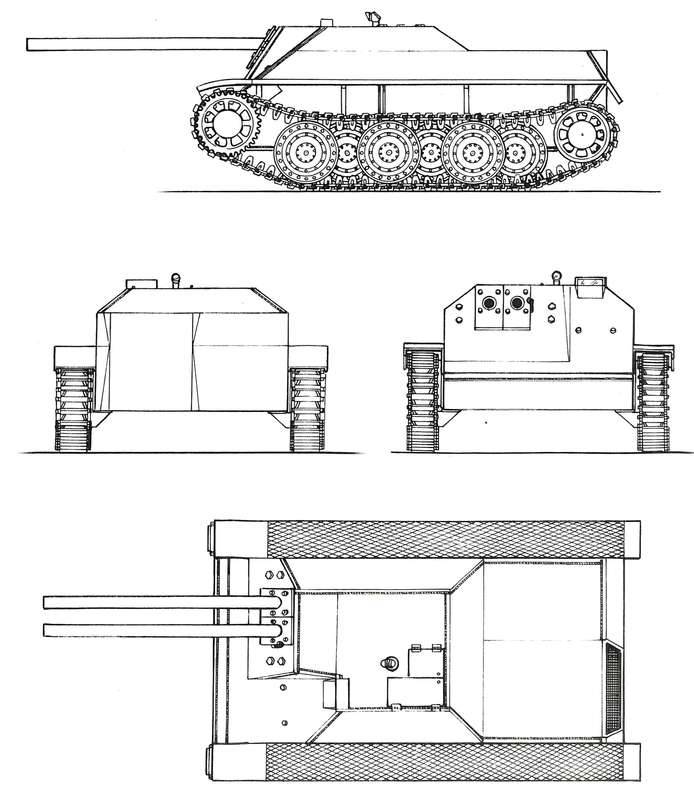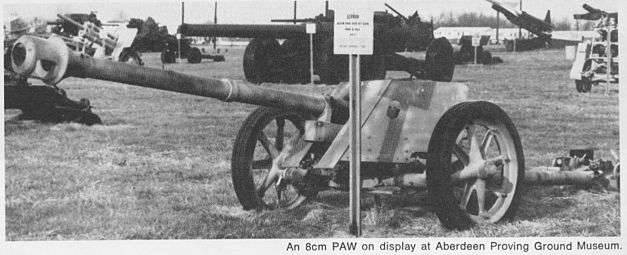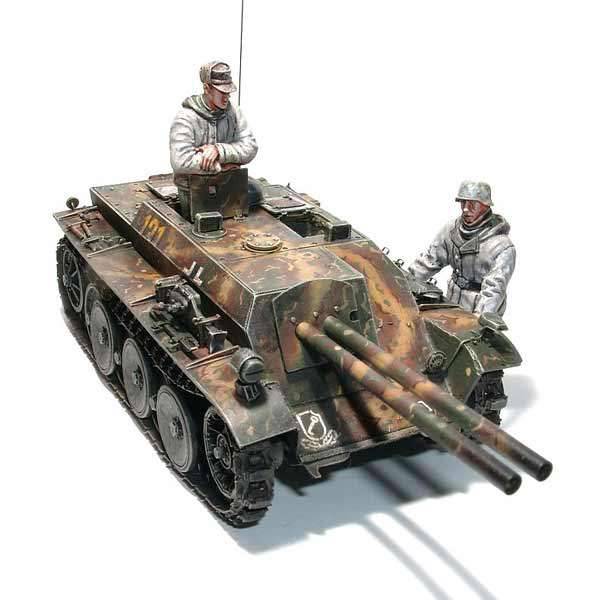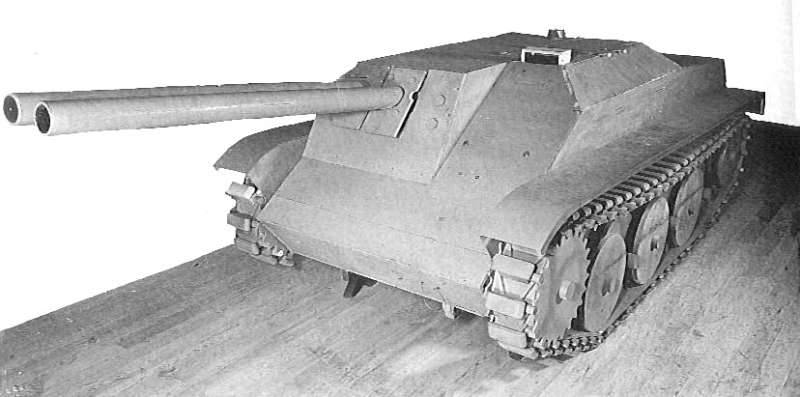Project of self-propelled artillery Kleinpanzerjäger Rütscher (Germany)
History The Kleinpanzerjäger Rütscher project began in 1942. At that time, the German military leadership ordered the development of promising fighters tanks light class. Several design bureaus and factories were involved in the work. Among others, the creation of a promising self-propelled gun was carried out by specialists from BMW and Wesserhütte. Together, they created a new armored vehicle, which was distinguished by relatively small dimensions, but at the same time carried a fairly powerful weapon that allowed it to fight against existing enemy tanks.
The Rütscher project was prepared for the start of the 1944 of the year, when the command compared the options presented and delivered its verdict. In February, a light tank destroyer Panzerjäger 44 (t) Hetzer was recommended for serial production and commissioning. Soon began preparations for the full-scale production of such equipment. The project of BMW and Wesserhütte, in turn, remained out of work and was forgotten for some time.
In less than a year, in January 1945, the work on the Kleinpanzerjäger Rütscher project was resumed. The successes of the allies and the movement of the front had a serious impact on the possibilities of German industry. She lost the enterprise behind the enterprise, and in this connection lost the ability to manufacture certain products, including some combat vehicles. Due to the loss of the Czechoslovak plants that produced the Hetzer self-propelled gun, Germany needed a new armored vehicle project that could be built on the remaining enterprises.
After the "reanimation" of the project, it was decided to change the basic requirements for it. To speed up work, improve manufacturability and improve performance, it was proposed to make speed and mobility the main priority of the project. Protection and firepower also remained important aspects of the project, but their growth was associated with an increase in combat mass and therefore could affect mobility. Thus, the perspective Rütscher self-propelled guns should have minimal dimensions and be as light as possible.
Unlike the mass of other German self-propelled guns of the time, the Kleinpanzerjäger Rütscher was not proposed to build on the basis of one of the existing chassis. Instead, it was planned to develop a new case and chassis that meet the requirements for size and weight. As a result, the finished self-propelled gun had some similarities with other armored vehicles, but there were also noticeable differences.
The self-propelled gun of the new type was to receive a hull that resembled the corresponding units of the previous German self-propelled guns. It was proposed to use an inclined frontal sheet with a small box-like superstructure to place the guns. The sides of the hull were proposed to be made in the form of a structure of vertical lower parts and inclined upper, connected to the roof. The aft part of the hull was supposed to have a lower height compared to the front wheelhouse, which was due to the size of the various units.
Despite the requirements relating to compactness, the Rütscher self-propelled gun was to be built according to the layout traditional for German armored vehicles, which did not contribute to a reduction in vehicle height. In front of the hull, there were transmission units associated with driving wheels, behind them was the total habitable volume, which united the control department and the fighting compartment. In the stern it was proposed to place the engine.

Projection machine. Picture Foto-transporta.ru
The body should be assembled from armor plates of relatively small thickness. Front plates should have a thickness of 14,5 mm. Other parts of the body were proposed to be made of 8-mm sheets. Such armor allowed to protect the crew and units of the machine only from rifle weapons and fragments of some artillery shells. Nevertheless, an increase in the level of protection was considered unacceptable, since a thickening of the armor would lead to a significant increase in the combat mass.
The basis of the power plant was to be the BMW CM3 Type 335 petrol engine with a power of 90 hp. The engine, cooling systems and fuel tanks were to be located in the aft compartment of the hull. With the help of a cardan shaft, passing under a habitable compartment, the engine had to transmit torque to the mechanical transmission in front of the hull. The main element of the transmission was the Allklauen ZF5-25 gearbox.
The running gear of the self-propelled gun was built on the basis of six road wheels on each side. Skating rinks with individual suspension were installed in a staggered manner. Driving wheels were placed in the front of the hull, guides - in the stern. It was proposed to use a large caterpillar with a width of 300 mm.
The crew of the Kleinpanzerjäger Rütscher self-propelled gun was to consist of two people, a driver and a commander who served as a loader and gunner. The driver's seat was located in front of the hull, on its left side. The commander was placed in the rear of the habitable compartment, near the starboard side. For access to the crew seats in the front and rear of the roof were provided two hatches. In order to maintain an acceptable level of frontal projection protection, it was decided to abandon the inspection hatches for the driver. For this reason, both the driver and the commander should have monitored the terrain only through periscopic instruments.
Requirements for weight and firepower imposed some restrictions on the choice of the main weapon. For example, the available anti-tank guns of the 75 mm caliber had insufficient power, and the 88-mm systems were too heavy and could damage the design of the machine with great efficiency. The authors of the project found an original way out of this situation. For the armament of the Rütscher self-propelled guns, it was proposed to use two Panzerabwehrwerfer 600 cannons (PAW 600, also the 8H63 designation) of the 80 mm caliber, distinguished by relatively high characteristics. The design of this tool, developed by Rheinmetall, used some interesting original ideas. With their help, it was possible to reduce the weight of the propellant charge and lighten the barrel, but at the same time to ensure a relatively high initial velocity of the projectile. Due to the cumulative ammunition, it was planned to ensure high armor penetration.

PAW 600 gun on the towed carriage. Photo of Wikimedia Commons
The PAW 80 600-mm gun was equipped with a sleek barrel of lightweight construction with a 38 caliber length and had to work along the so-called. two-chamber principle. The unitary projectile Wgr.Patr.4462 had a special plate with small holes that blocked the bore. During the shot, propellant ignition occurred, accompanied by the formation of a large amount of powder gases. Through the holes in the plate, the gases had to come out of the sleeve and fill the volume in front of the projectile. In this case, the plate was held in its place by a special pin and did not allow the projectile to budge. After reaching a given pressure difference in the sleeve (high pressure chamber) and in the space in front of the projectile (low pressure chamber), the pin was cut, after which the projectile could begin to move along the barrel. Despite the use of a relatively small propellant charge and light barrels, the initial velocity of the projectile reached 520 m / s.
A cumulative 8 cm Pwk.Gr.5071 projectile could hit targets at ranges up to 750 m and punch up to 140 mm homogeneous armor. At the same time, in the course of testing, shots were also carried out at great distances, up to 2 km, without losing the effectiveness of the projectile. Also known about the existence of high-explosive fragmentation projectile, which could be thrown at 6-6,2 km.
Initially, the PAW 600 cannon was proposed as a towed system on a wheeled carriage. For use in the Kleinpanzerjäger Rütscher self-propelled gun, it was decided to develop a new twin gun installation. In front of the armored felling of the ACS, a twin installation for two guns with common guidance systems was to be located. Rough horizontal guidance should be made by turning the whole machine, and for fine, as well as for lifting barrels, mechanisms with manual drives were proposed. For aiming the guns should have been equipped with a general telescopic sight mounted to the right of them.
Due to the dense layout of the prospective self-propelled gun was supposed to be small in size. The length of the hull was 3,55 m (4,85 m including guns), the width did not exceed 1,85 m, and the height was reduced to record 1,36 m. At the same time, the machine had to differ by a relatively large combat weight - 38,5 t. the mass can be suspected of having some kind of error. Given the size of the Rütscher ACS, it’s hard to imagine that it could even weigh 10 t, not to mention larger indicators. Perhaps the real combat mass was determined at the level of 3,85 t, and then a mistake crept into the historical research.
According to some data, in parallel with the self-propelled gun, a carrier of ammunition was developed on a similar chassis. It should have been distinguished from the basic SAU by the absence of armament and a reduced cabin, which provided for a large number of racks for ammunition. With a height of 1 m and a total mass of 3 and T, the carrier could transport up to 1 and shells. It is noteworthy that the parameters of the carrier of ammunition may be a hint of the real mass of self-propelled guns and the fallacy of data on 38,5 tons.

Model Kleinpanzerjäger Rütscher. Visually shows the size of the machine. Photo Strangevehicles.greyfalcon.us
An important feature of the Kleinpanzerjäger Rütscher light tank destroyer project was the use of only those components that could be manufactured in Germany. Thanks to this, the industry, rapidly losing enterprises and resources, could give the army the required amount of equipment. Nevertheless, it was only in theory, but in practice the situation was different.
The development of the Rütscher project was resumed in January 1945. Within a few weeks, the development companies completed the design and prepared the necessary documentation for the updated project. In April, was built a full-size mock self-propelled model, which demonstrated its main features. There was an opportunity to build and test a prototype, and according to the results of its tests, serial construction of a new technology could begin.
However, the mass production of new self-propelled guns could prevent problems with the supply of necessary weapons. The PAW 600 guns were put into series in the last months of 1944. At the beginning of 1945, the army received the first batch of such guns on towed carriages in the number of 81 units. Before the beginning of spring 220 guns and more than 30 thousand shells were manufactured for them. For various reasons, less than half of the built guns hit the front, and the rest remained at the manufacturer. At the same time, the pace of production left much to be desired, which could adversely affect the production of self-propelled guns, or hit the supply of guns for field artillery.
In April, BMW and Wesserhütte built 1945, a wooden full-size model of a new tank destroyer. Few weeks remained in Europe until the end of the war, because of which further work on the project was useless. Naturally, before the surrender, the German industry could not even begin building a prototype machine like Kleinpanzerjäger Rütscher.
Due to the successes of the Red Army and other troops of the anti-Hitler coalition, the Rütscher project was not implemented and did not advance beyond the layout checks stage. As a result, German troops remained without promising self-propelled artillery with promising characteristics. The reason for this failure was the late start of the project. After some downtime, the development of self-propelled guns was resumed only in January of the 1945 year, when there was no time left for full-fledged work. The Kleinpanzerjäger Rütscher machine could become the world's first self-propelled gun carrier with two chambers, however, it was able to reach construction in metal.
Based on:
http://strangevehicles.greyfalcon.us/
http://aviarmor.net/
http://mirtankov.su/
http://forum.axishistory.com/

Information